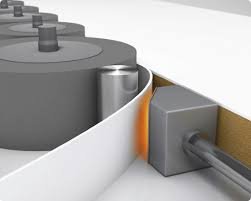Edge banding is something we see all the time but rarely think about—until we need to use it. If you’re setting up a production line or just DIYing at home, understanding whether edge banding always involves glue could save you time, money, and headaches.
Edge banding doesn’t always have glue. Some types come pre-glued, others require external adhesive, and a few don’t use glue at all. It depends on the material and application method.

Choosing the right edge banding can affect not only your workflow but also the quality and durability of your finished product. Below, I break down the main types, the role of glue, and how to decide what fits your needs best.
What types of edge banding exist, and how are they applied?
Edge banding is not one-size-fits-all. There are several types, and each works differently depending on how it’s applied.
Edge banding comes in PVC, ABS, wood veneer, melamine, and acrylic. Application methods include hot-melt glue, pre-glued tape, laser, and hot-air techniques.

Types of Edge Banding
Let me list the most common types I’ve worked with:
| Type | Material | Common Use Cases | Pros | Cons |
|---|---|---|---|---|
| PVC | Plastic | Cabinets, shelves | Flexible, cost-effective | Not eco-friendly |
| ABS | Plastic (eco) | Office furniture | Recyclable, durable | Higher cost than PVC |
| Wood Veneer | Thin wood layer | High-end furniture | Natural look, elegant | Needs precise handling |
| Melamine | Paper/resin | Budget furniture | Cheap, many designs | Brittle, chips easily |
| Acrylic | Plastic (thick) | Luxury finishes | Glossy, impact-resistant | Requires laser/hot air tech |
Now let’s talk about how these get applied:
- Pre-glued tape: has a thin layer of glue that activates with heat (usually an iron or edge bander)
- Glue-applied (hot-melt): glue is melted and applied during the process, sticks instantly
- Laser edge banding: no glue, uses heat and pressure to bond
- Hot-air edge banding: like laser, but uses hot compressed air to activate a reactive layer
Every application method affects setup cost, bonding strength, and finish quality. I’ve seen smaller shops love pre-glued tapes for their low cost, but serious production lines often go for hot-melt or laser for better speed and finish.
Is pre-glued edge banding the same as glue-free edge banding?
This question gets asked a lot, and I understand why. “Pre-glued” and “glue-free” sound similar, but they’re very different.
Pre-glued edge banding has glue on it already, while glue-free options like laser or hot-air banding use other bonding methods without visible glue.

Let’s Clear This Up
Pre-glued: glue is factory-applied. You heat it, and it sticks.
Glue-free: bonding happens with heat and pressure, but no glue is added by you.
Here’s how they compare:
| Feature | Pre-glued Tape | Glue-Free (Laser/Hot-Air) |
|---|---|---|
| Adhesive Needed | No (already on tape) | No (built-in bonding layer) |
| Equipment Cost | Low | High |
| Bonding Strength | Moderate | Very High |
| Application Method | Heat gun or iron | Specialized machinery |
| Finish Quality | Basic | Seamless, high-end look |
In my experience, glue-free systems are best for companies chasing premium finishes and long-term durability. But pre-glued is still great for quick fixes or small batches.
How does hot-melt glue work in edge banding applications?
Hot-melt glue is still the backbone of most edge banding operations, especially in traditional or mid-range setups.
Hot-melt glue melts in the edge banding machine, then sticks the banding material to the board as it cools. It bonds fast and strong.

What Makes Hot-Melt Glue So Popular?
I’ve used hot-melt glue systems on both large and small-scale jobs. The key reasons they’re so popular are:
- They’re fast. You can edge hundreds of panels per hour.
- They’re cheap. Glue sticks or pellets are inexpensive.
- They’re forgiving. You don’t need extreme precision.
Different Types of Hot-Melt Glue
| Glue Type | Base Material | Strength | Heat Resistance | Cleanup Difficulty |
|---|---|---|---|---|
| EVA (Ethylene Vinyl Acetate) | Common choice | Good | Medium | Easy |
| PUR (Polyurethane Reactive) | High-end | Excellent | High | Hard |
If you’re using EVA, it works fine for indoor furniture. But for moisture-heavy or high-temperature settings like kitchens or bathrooms, PUR gives better performance. Just be ready to invest in maintenance and equipment upgrades.
What are the alternatives to glue-based edge banding?
Glue has been the default for decades, but it’s not the only way to apply edge banding.
Alternatives include laser, hot-air, and mechanical methods. These don’t use traditional glue but still create strong, durable bonds.

Let’s Talk Alternatives
1. Laser Edge Banding
- Uses infrared to melt a reactive layer on the edge band
- Seamless joint, no visible glue line
- Very durable, high resistance to moisture and heat
2. Hot-Air Edge Banding
- Blows hot air to melt a thermoplastic layer on the band
- Great for glossy or acrylic edges
- Cleaner workspace, fewer fumes
3. Mechanical Edge Banding
- Sometimes used in rustic or experimental designs
- Edge is nailed, stapled, or locked in via mechanical design
- Not common in commercial furniture, but interesting in art pieces
Here’s a quick comparison:
| Method | Needs Glue? | Finish Quality | Equipment Cost | Eco Impact |
|---|---|---|---|---|
| Laser | No | Excellent | High | Low |
| Hot-Air | No | High | High | Low |
| Mechanical | No | Low to Medium | Low | Medium |
In my opinion, glue-free methods will dominate future factories. They reduce waste, look better, and support cleaner production lines.
How to choose the right edge banding based on your production line?
So now comes the real question—what should you use? That depends on your setup, budget, and quality goals.
Choose based on your production volume, finish needs, and investment level. Smaller shops might stick with pre-glued tapes, while large factories go with laser or hot-air solutions.

Let Me Break It Down
For Small Shops or DIY
- Go for pre-glued or EVA hot-melt
- Equipment is cheap or not needed
- Perfect for short runs, simple designs
For Medium-Sized Manufacturers
- Use EVA glue machines or upgrade to PUR
- Better finish and stronger bond
- Equipment cost is moderate
For High-End or Mass Production
- Laser or hot-air systems
- Seamless edges, less waste
- High investment, but long-term payoff
Here’s a guide I often share:
| Production Size | Suggested Method | Why |
|---|---|---|
| Hobby/DIY | Pre-glued | Easy, affordable |
| Small Factory | EVA Glue | Reliable, scalable |
| Mid Factory | PUR Glue | Durable, premium finish |
| Large/Automated | Laser/Hot-Air | Seamless, efficient, clean |
I’ve helped clients switch systems based on their goals. Some started with tape, then upgraded to PUR once they saw quality gaps. Others went straight to laser when launching high-end furniture lines. It’s not just about the glue—it’s about what you want your product to say.
Conclusion
Edge banding doesn’t always need glue. It depends on the method, material, and how far you want to go in terms of quality and finish.





